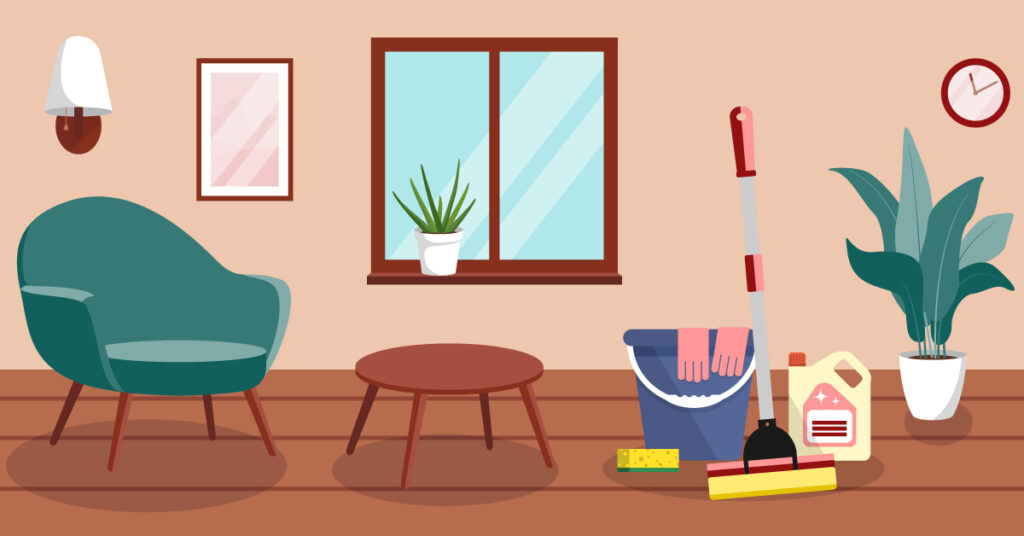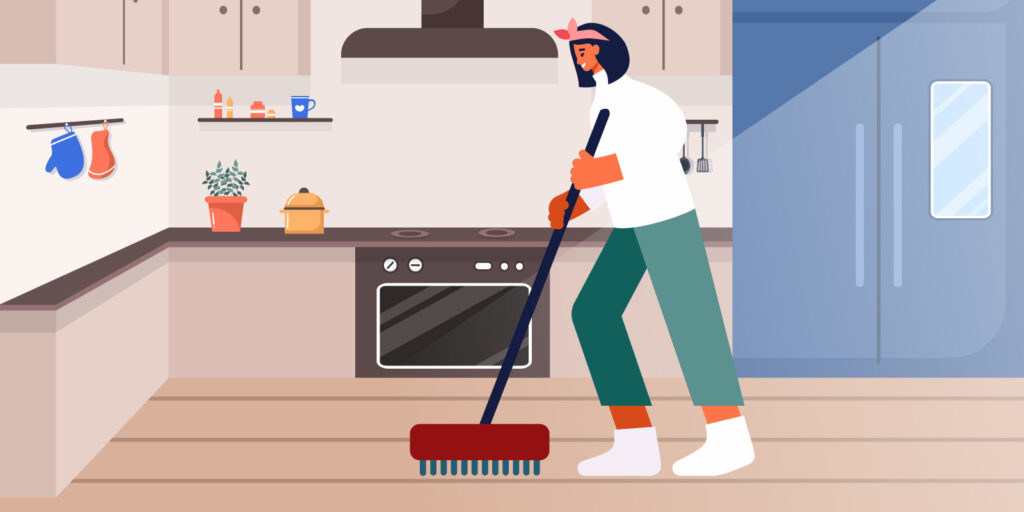Hardwood floors are a timeless and beautiful addition to any home, offering warmth, elegance, and durability. However, to maintain their pristine appearance and longevity, cleaning and caring for them properly is essential. This comprehensive guide will explore the best practices for cleaning hardwood floors, including routine maintenance, deep cleaning, and addressing common issues such as spills, stains, and scratches.
Routine Cleaning and Maintenance
To keep your hardwood floors looking their best, they’ll need regular cleaning and maintenance. Incorporating the following steps into your routine will help you prevent the buildup of dirt, dust, and grime.
Sweep or Dust Mop Daily
Use a soft-bristle broom or a dry microfiber dust mop to remove dirt, dust, and pet hair from your hardwood floors daily. This will prevent the accumulation of debris that can scratch and damage the surface over time.
Vacuum Weekly
Vacuum your hardwood floors weekly using a vacuum cleaner with a soft brush attachment or a hardwood floor setting. Avoid using vacuums with beater bars or rotating brushes, as they can cause scratches and damage to the floor’s finish.
Clean Spills Immediately
To prevent staining and warping, clean up spills as soon as they occur using a soft, absorbent clean cloth. Use a damp cloth with a small amount of gentle hardwood floor cleaner for sticky or greasy spills.
Deep Cleaning
Even with regular maintenance, your hardwood floors may require more thorough cleaning from time to time. Deep cleaning can help remove stubborn dirt and grime and restore the shine and luster of your floors.
Use a Hardwood Floor Cleaner
Select a gentle, pH-neutral hardwood floor cleaner specifically designed for use on hardwood floors. Avoid using abrasive cleaners, ammonia, or vinegar, as these can damage the finish.
Mop with a Microfiber Pad
Dampen a microfiber mop pad with the cleaning solution and wring it out thoroughly, ensuring it is only slightly damp. Excess moisture can cause damage to your hardwood floors.
Clean in Sections
Work in small sections, starting at one end of the room and working your way across. Apply the cleaner evenly to the floor, following the grain of the wood, and use a back-and-forth motion to lift dirt and grime.
Dry the Floor
After mopping, use a clean, dry microfiber cloth or mop pad to remove any remaining moisture from the floor. This step is essential to prevent water damage, such as warping or staining.
Dealing with Spills, Stains, and Scratches
Despite your best efforts, accidents can happen, leading to spills, stains, and scratches on your hardwood floors. Here’s how to tackle some common messes that may arise:
- Water Spills: If water spills on your hardwood floors, immediately wipe it up with a soft, absorbent cloth. If the water has been standing for a while, you may need to use a fan or dehumidifier to help dry the area thoroughly.
- Stains: For stubborn stains, such as ink, wine, or pet accidents, apply a small amount of hardwood floor cleaner to a soft cloth and gently rub the stain until it is removed. Be careful not to scrub too hard, which can damage the finish.
- Scratches: Minor scratches can often be camouflaged using a touch-up kit or wood stain marker that matches the color of your hardwood floor. For deeper scratches or gouges, you may need to consult a professional for repair options, such as sanding and refinishing the affected area.
Best Mop Options For Hardwood Floors

Using the right mop on hardwood floors is essential to protect the surface and maintain its appearance. The best mops for hardwood floors are gentle, absorbent, and easy to maneuver. Here are some of the top mop types and specific recommendations for hardwood floors:
Microfiber mops
Microfiber mops are highly recommended for hardwood floors, as they are gentle on the surface, absorbent, and easily pick up dust and dirt. Some popular microfiber mop options include:
Flat Mops with Reusable Pads
Flat mops with reusable, washable mop head pads are eco-friendly and effective for hardwood floor cleaning. Some popular flat mop options include:
- Swiffer WetJet Wood Floor Mopping and Cleaning Starter Kit (use with a gentle hardwood floor cleaning solution and these reusable pads)
- Rubbermaid Reveal Spray Mop
Steam Mops
Although steam mops are generally not recommended for hardwood floors due to the risk of excessive moisture, a few models are specifically designed for use on sealed hardwood floors. Always check with your floor manufacturer before steam cleaning, and use with caution. Some popular steam mop options for sealed hardwood floors include:
When using a mop on hardwood floors, avoiding excessive moisture is crucial, as this can lead to damage such as warping or staining. Always wring out your mop thoroughly before applying it to the floor, and dry any remaining moisture with a clean, dry cloth after cleaning.
DIY Cleaning Options
DIY cleaners for hardwood floors are homemade cleaning solutions made from natural and readily available household ingredients. These cleaning products are typically gentler on your hardwood floors and can save you money compared to commercial products.
Here are two popular DIY wood floor cleaner recipes and the steps of how to clean wood floors with them:
Vinegar and water solution:
- 1 gallon of warm water
- 1/2 cup of white vinegar
Mix the ingredients in a bucket, and then dip a microfiber mop or cloth into the solution. Wring it out well to ensure it’s only slightly damp. Clean the floor by following the grain of the wood, and then dry the surface with a clean, dry cloth to prevent water damage.
Olive oil and lemon essential oil cleaner:
- 1 gallon of warm water
- 2 tablespoons of olive oil
- 15 drops of lemon essential oil
Combine the ingredients in a bucket and mix well. Dip a microfiber mop or cloth into the solution, wring out excess moisture, and clean the floor by following the grain of the wood. The olive oil can add a subtle shine to your hardwood floor, while the lemon essential oil provides a pleasant fragrance and mild cleaning properties.
Note: While these DIY cleaners are generally safe for hardwood floors, it’s always a good idea to test them on a small, inconspicuous area of your floor first to ensure they don’t cause any adverse reactions. Additionally, always avoid using excessive moisture when cleaning hardwood floors, as this can lead to damage such as warping or staining.
What Can Damage A Hardwood Floor
Hardwood floors are durable and long-lasting but can be susceptible to damage if not cared for properly. Here are some common factors that can damage hardwood floors:
- Moisture: Excessive moisture can cause hardwood floors to warp, buckle, or develop stains. It’s essential to clean up spills immediately, avoid wet mopping, and maintain a consistent indoor humidity level between 30% and 50% to eliminate any excess water.
- Scratches and dents: Furniture, pet nails, high heels, or moving heavy objects can cause scuffs or dents in hardwood floors.
- Dirt and grit: Small particles of dirt, sand, or gravel can scratch the surface of hardwood floors when walked on or ground into the finish. Regular sweeping or vacuuming can help remove these particles and protect your floors.
- Sunlight: Prolonged exposure to direct sunlight will cause hardwood floors to fade or change color. Use window treatments, such as curtains or blinds, to protect your floors from excessive sunlight.
- Inadequate cleaning: Using the wrong cleaning products or methods can damage hardwood floors. Avoid using harsh chemicals, abrasive cleaners, or concentrated vinegar, and always use a soft, slightly damp mop or cloth when cleaning.
- Poor installation or subfloor: If hardwood floors are not installed correctly, or the subfloor is uneven or damaged, it can cause issues such as buckling, gaps, or squeaking. Proper installation and maintenance of the subfloor are essential for the longevity of hardwood floors.
- Fluctuating temperature and humidity: Drastic changes in temperature and humidity can cause hardwood floors to expand and contract, leading to gaps, warping, or cracking.
Preventing Damage to Hardwood Floors
Taking proactive measures to protect your hardwood floors from damage is essential for maintaining their appearance and longevity. Here are some cleaning tips to help you keep your hardwood floors looking their best:
- Use protective pads: Place felt or rubber pads on the bottom of furniture legs to prevent scratches and dents. Regularly check and replace worn pads as needed.
- Implement a no-shoe policy: Encourage family members and guests to remove their shoes before entering your home. This will help reduce the amount of dirt, grit, and moisture tracked onto your hardwood floors.
- Use area rugs and mats: Place area rugs, door mats or floor runners in high-traffic areas, such as entryways and hallways, to protect your hardwood floors from wear and tear. Be sure to use rugs with a natural, non-slip backing to avoid damage to the floor’s finish.
- Maintain a consistent indoor climate: Excessive humidity or dryness can cause hardwood floors to expand, contract, or warp. Maintain a consistent indoor humidity level between 30% and 50% and a temperature between 60-80°F (15-27°C) to minimize the risk of damage.
- Regularly trim pet nails: Keep your pet’s nails trimmed to prevent scratches on your hardwood floors. Additionally, placing pet beds and mats in designated areas can help reduce the risk of damage from pet accidents.
Proper cleaning and maintenance are essential for keeping your hardwood floors looking beautiful and prolonging their lifespan. By incorporating daily and weekly cleaning routines, deep cleaning periodically, and addressing spills, stains, and scratches promptly, you can maintain the elegance and durability of your hardwood floors for years to come.
By following these steps, you will have the best hardwood floors you could imagine!
You might also be interested in: Mold Vs Mildew – How To Identify It And The 4 Best Ways To Get Rid Of It




